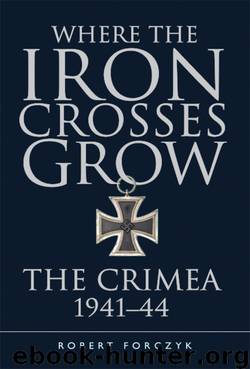Where the Iron Crosses Grow by Robert Forczyk

Author:Robert Forczyk
Language: eng
Format: epub
Tags: Where the Iron Crosses Grow: The Crimea 1941–44
ISBN: 9781782009764
Publisher: Random House Publisher Services
Wack’s pioneers were unable to complete the conquest of the battery by nightfall and spent the night involved in close combat. At dawn, Wack led a platoon-size raid that overwhelmed the remaining defenders and captured the battery. Most of the garrison fought to the death, but 36 naval gunners emerged from an underground shelter and surrendered. Wack’s company had suffered eight dead or missing and 14 wounded in the assault, but demonstrated the kind of small-unit leadership and aggressiveness that wins battles. Immediately after the fall of the battery, both IR 436 and IR 437 were pulled out of the line to refit. Gottlob Bidermann noted that by this point his division was spent, and that one company was reduced to only two NCOs and a few enlisted men.70 While the 132. Infanterie-Division eliminated Coastal Battery No. 12 and the remnants of the 95th Rifle Division, the 24. Infanterie-Division cleared the town of Bartenyevka and closed in on the final cluster of Soviet-held fortifications on the north side of Severnaya Bay.
Meanwhile, the engineers of 1./Pionier-Bataillon 173 spent June 18 trying to demolish Coastal Battery No. 30’s two damaged 305mm turrets with fuel drums and satchel charges, but they succeeded only in causing cracks in the armored plates on the turrets. Unable to force their way into Bastion I, even with flamethrowers, the German engineers did succeed in damaging the air-handling system, and the underground bunkers soon filled with smoke. At first a few soot-covered Soviet soldiers emerged from an exit, then more, until 108 had surrendered. However, Aleksandr remained inside with about 90 more that refused to surrender.
Petrov did commit Major Petr P. Zelinsky’s 138th Naval Infantry Brigade to try and regain some ground on the northern side of Severnaya Bay on June 18, but in typical fashion the counterattack was poorly planned. Only three of Zelinsky’s four rifle battalions had arrived near the Serpentine when the attack was ordered and almost none of his artillery. His infantrymen attacked the 22. Infanterie-Division’s combat outposts, which simply pulled back to their main line of resistance (known as the Hauptkampflinie, or HKL) and called in copious amounts of artillery fire upon Zelinsky’s naval infantrymen. All three attacking battalions were decimated and forced to retreat, leaving 400 prisoners for the Germans. This ill-advised and hasty attack crippled Petrov’s last major intact unit on the northern side of Severnaya Bay.
On June 19, two battalions from IR 97 moved southwest from Coastal Battery No. 12, with their right flank on the Black Sea. Enemy resistance was fairly light, but the German troops were increasingly wary of mines by this point and the infantry was unwilling to advance too far without engineer support. Engineers were still busy reducing Coastal Battery No. 30 as well as mopping up Battery No. 12, so only 1./Pionier-Bataillon 132 was initially available to support the advance of IR 97. By the afternoon of June 19 the German infantry came within sight of the North Fort, a large octagonal fort that was built before the Crimean War.
Download
This site does not store any files on its server. We only index and link to content provided by other sites. Please contact the content providers to delete copyright contents if any and email us, we'll remove relevant links or contents immediately.
| Africa | Americas |
| Arctic & Antarctica | Asia |
| Australia & Oceania | Europe |
| Middle East | Russia |
| United States | World |
| Ancient Civilizations | Military |
| Historical Study & Educational Resources |
The Radium Girls by Kate Moore(11633)
100 Deadly Skills by Clint Emerson(4697)
The Templars by Dan Jones(4561)
Rise and Kill First by Ronen Bergman(4549)
The Doomsday Machine by Daniel Ellsberg(4250)
The Rape of Nanking by Iris Chang(4024)
Killing England by Bill O'Reilly(3900)
Hitler in Los Angeles by Steven J. Ross(3803)
Stalin by Stephen Kotkin(3731)
12 Strong by Doug Stanton(3420)
Hitler's Monsters by Eric Kurlander(3168)
Blood and Sand by Alex Von Tunzelmann(3060)
Darkest Hour by Anthony McCarten(3019)
The Code Book by Simon Singh(2866)
The Art of War Visualized by Jessica Hagy(2845)
Hitler's Flying Saucers: A Guide to German Flying Discs of the Second World War by Stevens Henry(2625)
Babylon's Ark by Lawrence Anthony(2435)
The Second World Wars by Victor Davis Hanson(2423)
Tobruk by Peter Fitzsimons(2380)
